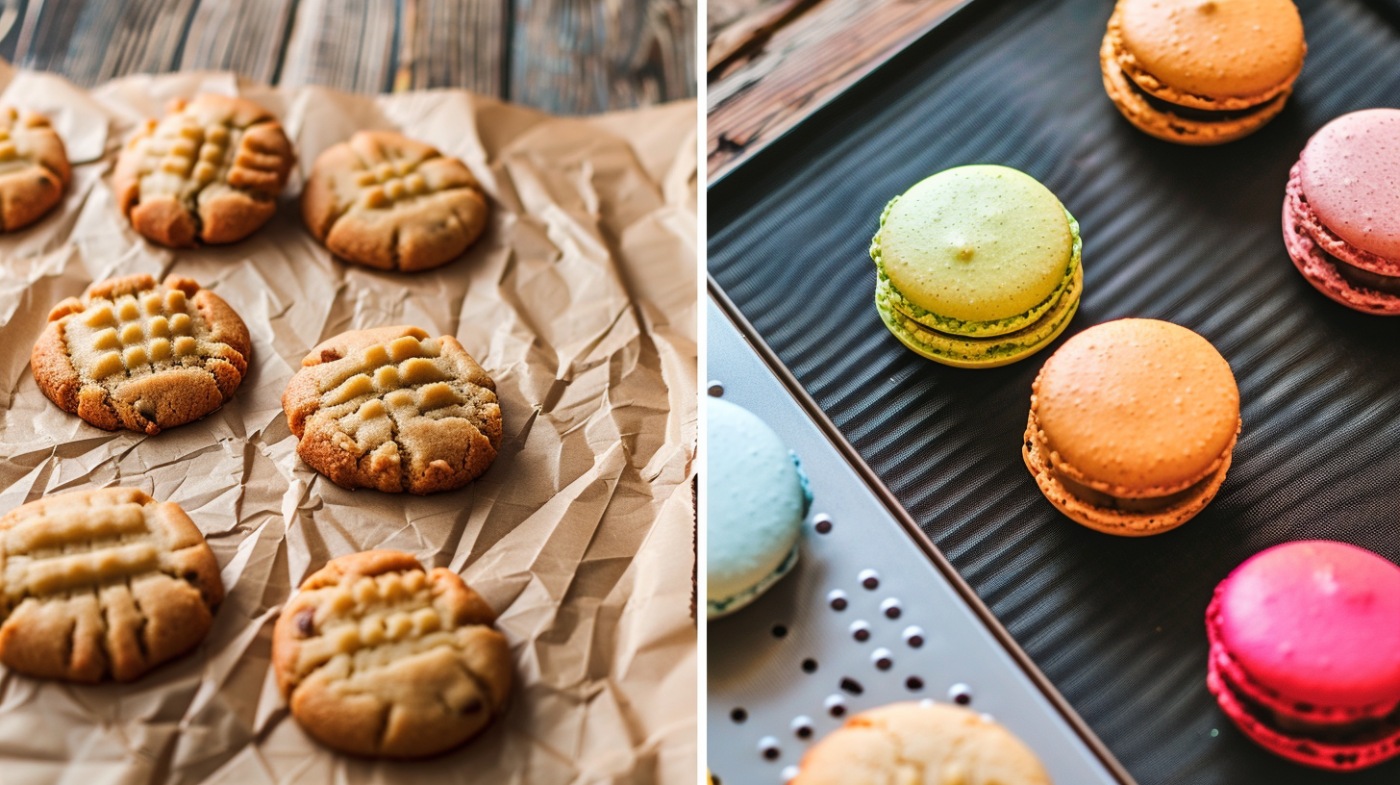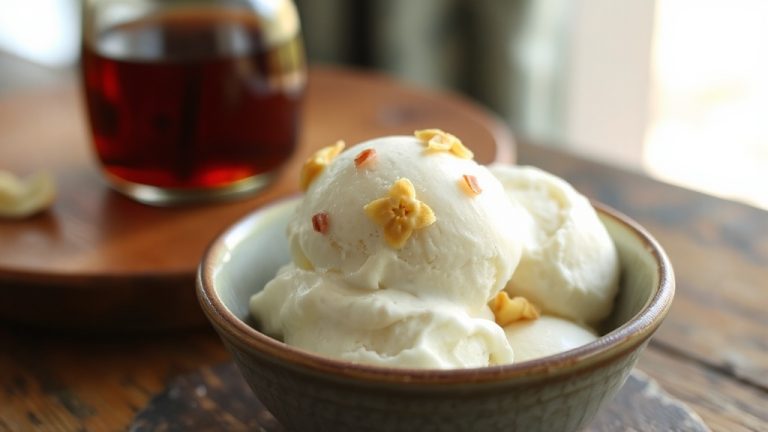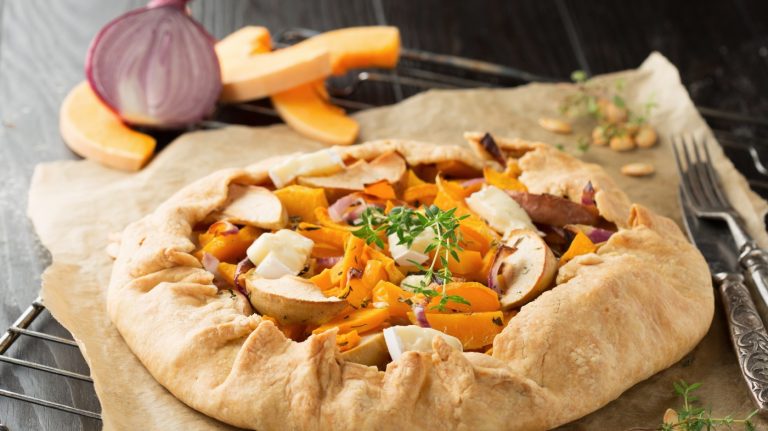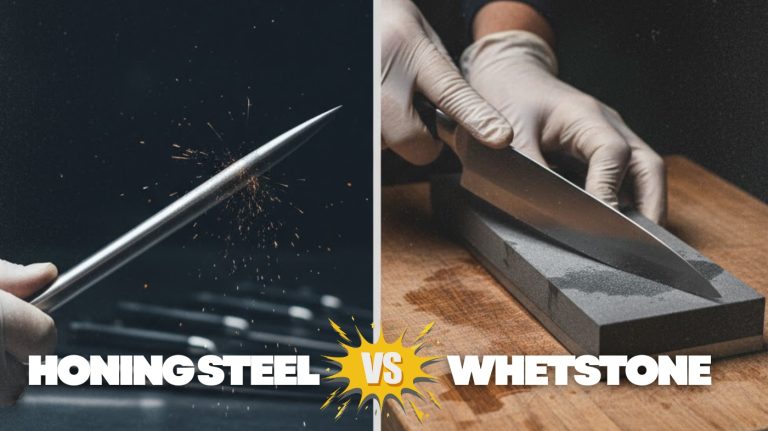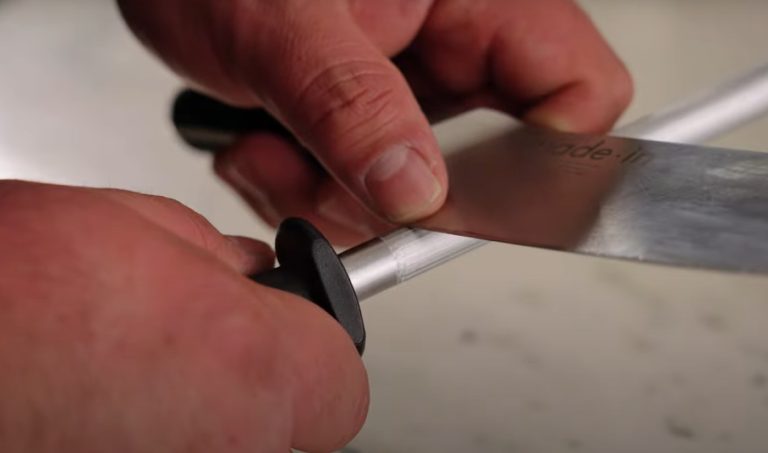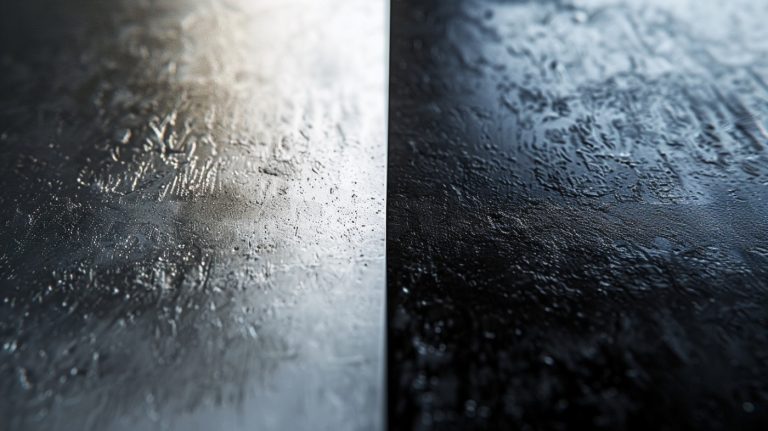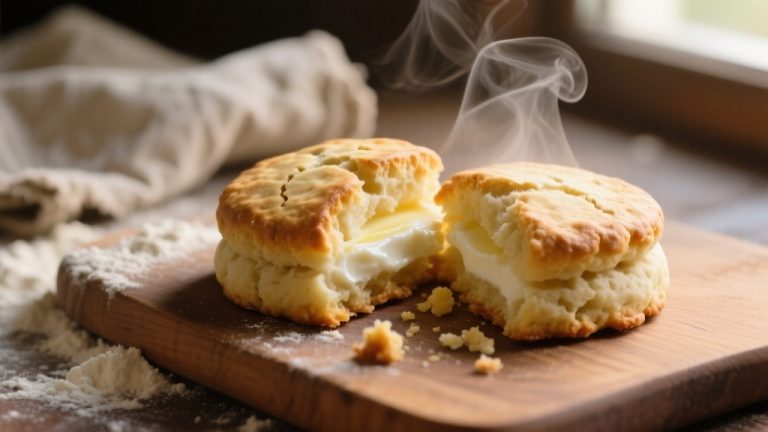Parchment Paper Vs Silicone Mat: What Works Best for Baking?
When choosing between parchment paper and silicone mats, consider your baking needs. Parchment paper is a one-time-use, cost-effective option that excels at absorbing fat for crispy edges, perfect for cookies and lining cake tins. It does tear easily, so handle it with care.
Silicone mats, on the other hand, are reusable up to 2000 times and resistant to high temperatures. They prevent sticking and are easy to clean, making them great for sticky recipes.
Each has its pros and cons, and understanding them can elevate your baking game. You’ll find out even more useful insights as you explore further.
Key Takeaways
- Parchment paper is disposable and cost-effective, ideal for single-use baking tasks, while silicone mats are reusable and durable for up to 2000 uses.
- Silicone mats can withstand higher temperatures (up to 550°F) compared to parchment paper (maximum 450°F), offering more versatility in baking.
- Parchment paper absorbs fat, enhancing crispiness in baked goods, while silicone mats maintain uniform shape and prevent sticking without added grease.
- Cleaning parchment paper is simple due to its single-use nature, whereas silicone mats require washing but can be reused multiple times.
- Parchment paper is customizable for various pan sizes, while silicone mats provide consistent baking surfaces for sticky recipes like macarons.
Material Composition and Safety
When it comes to baking, choosing the right tools can make all the difference, and silicone baking mats stand out for their impressive material composition and safety features.
Made from food-grade silicone, these mats often incorporate fiberglass mesh for added durability, ensuring they can handle all your baking tasks without compromising performance.
The nonstick surfaces make it easy for you to bake everything from cookies to pastries without worrying about sticking or tearing.
Safety is paramount in the kitchen, and silicone baking mats excel in this area. They’re chemically inert, meaning they won’t leach harmful substances into your food, so you can bake with peace of mind.
Plus, their reusable nature makes them a sustainable choice—unlike parchment paper, which you toss after one use, silicone mats can last for years with proper care.
Cleaning is a breeze, too. Simply wash them with warm soapy water, and stubborn baked-on food usually wipes off effortlessly.
With silicone baking mats, you get a reliable, safe, and eco-friendly baking solution that enhances your culinary experience.
Temperature Resistance and Versatility
Baking enthusiasts will appreciate the impressive temperature resistance and versatility of silicone baking mats.
These mats can withstand temperatures ranging from 450°F to 550°F, depending on the manufacturer, making them ideal for a variety of baking tasks.
Unlike parchment paper, which is often single-use, silicone mats offer a reusable, nonstick surface that can handle up to 2000 uses.
Here’s a quick comparison to illustrate their benefits:
| Feature | Silicone Mats |
|---|---|
| Temperature Resistance | 450°F to 550°F |
| Reusability | Up to 2000 uses |
| Nonstick Surface | Yes |
| Suitable Baking Tasks | Cookies, pastries, candy making |
| Other Uses | Freezer and microwave safe |
The versatility of silicone mats doesn’t end with baking; their durability allows you to use them for high-heat cooking methods, like roasting. Plus, you can easily store them in the freezer or pop them in the microwave.
Cleaning and Maintenance Tips
How do you keep your silicone baking mats in top condition? Proper cleaning and maintenance are key to ensuring these versatile kitchen tools last through countless baking adventures.
Start by wiping down your silicone baking mat after each use. Food residue usually comes off easily with warm soapy water, and for a deeper clean, toss it in the dishwasher. Just remember to avoid using sharp utensils on the surface; they can damage the mat and expose the fiberglass underneath.
To maintain their nonstick properties, store your mats flat or rolled, steering clear of creasing. This simple step helps preserve their integrity for up to 2,000 uses.
While silicone mats can handle high temperatures—up to 480°F—never place them under a broiler, as the direct heat can degrade the material.
Best Uses for Parchment Paper
Parchment paper is your best friend when it comes to baking cookies, as it keeps them from sticking and guarantees they bake evenly.
When lining cake tins, it ensures that delicate cakes release easily without crumbling, making your baking experience smoother.
Whether you’re perfecting your cookie game or crafting beautiful cakes, parchment paper makes all the difference.
Cookie Baking Efficiency
Regarding cookie-baking efficiency, parchment paper often shines as the go-to choice for home bakers and professionals alike. This versatile paper prevents cookies from sticking, making removal a breeze without worrying about breakage.
By lining your half-sheet trays with parchment, you’ll notice how it absorbs excess fat, leading to those perfectly crispy, dry edges that everyone loves.
What’s great about parchment paper is its ability to be cut into custom sizes, allowing you to adapt it to various baking pans and cookie shapes. This flexibility means you can bake multiple sheets simultaneously without compromising the quality of your cookies.
You’ll find that cookies baked on parchment not only hold their shape exceptionally well but also boast a texture and flavor that taste testers often prefer over those baked on silicone mats.
Cake Lining Benefits
Lining your cake tins with parchment paper transforms the baking experience, ensuring cakes slide out effortlessly and intact. This simple addition provides numerous benefits that elevate your baking game:
- Non-stick properties: Parchment paper prevents cakes from sticking, allowing for a clean release without breakage.
- Even baking: It insulates your cake, helping to prevent scorching, especially in dark or non-stick pans.
- Customization: You can easily cut parchment paper to fit any pan shape or size, accommodating various cake recipes.
Using parchment paper is especially beneficial for delicate cakes and pastries, ensuring a smooth peel-off without leaving any residue.
This cost-effective solution means you can enjoy consistent results over multiple baking sessions without breaking the bank.
Plus, the ease of use and reliability makes it a favorite among bakers of all levels.
Best Uses for Silicone Mats
In the world of baking, silicone mats have become indispensable tools for both amateur and professional bakers alike. Their nonstick and heat-resistant properties make them perfect for a variety of baked goods.
For instance, if you’re tackling macarons, using silicone mats with printed templates guarantees your treats have a consistent size and shape every time.
You’ll also find these mats incredibly helpful for sticky tasks, like pouring molten caramel or mixing syrupy granola, thanks to their non-tearing surface. Bread bakers appreciate how easily they can transfer shaped loaves to the oven without damaging the dough.
Plus, with high-quality silicone mats that can withstand temperatures of up to 450°F or even 550°F, you can explore candy making without worry.
What’s more, many silicone mats come with ruler markings and conversion charts, enhancing usability for various baking and cooking applications.
While personal preference plays a role in choosing between silicone and parchment, the versatility and durability of silicone mats often make them a favorite in any kitchen.
Pros and Cons of Parchment Paper
While silicone mats have their advantages, parchment paper remains a popular choice among bakers for its affordability and versatility. Here are a few reasons why you might choose parchment paper:
- Customizable: You can easily cut parchment paper to fit various baking pans, making it adaptable to your needs.
- Non-Stick Surface: It’s perfect for preventing sticking, especially with delicate items like cakes and cookies.
Despite its many benefits, parchment paper has some drawbacks. It can tear easily during handling, which might frustrate you when you’re in the middle of baking.
Additionally, while silicone-treated parchment can be reused, traditional Quilon parchment is intended for single use, impacting sustainability.
Also, be mindful of the temperatures; it performs best between 420-450°F, which limits its use for certain recipes.
Pros and Cons of Silicone Mats
Choosing silicone mats for your baking needs can transform the way you approach your kitchen tasks, especially with their impressive durability and convenience.
One of the biggest pros is their non-stick surface, which eliminates the need for greasing pans. This makes cleanup a breeze and helps keep your recipes lighter by minimizing added fats.
Plus, these mats can withstand high temperatures, typically up to 450°F or even 550°F, making them suitable for various baking tasks, from cookies to candy making.
However, there are some cons to evaluate. Silicone mats don’t absorb excess fats, which can result in lighter-colored bottoms on your baked goods rather than the desired crisp, brown edges you might achieve with parchment paper.
Additionally, you may notice that cookies spread more than they’d on parchment, potentially affecting the texture and shape of your treats.
Expert Insights and Recommendations
When it comes to baking, expert insights suggest that utilizing both parchment paper and silicone mats can greatly enhance your results.
Here are three key points to take into account:
- Crispier Texture: Parchment paper absorbs excess fat, making it a favorite for baking cookies, resulting in that delightful crispiness you crave.
- Uniform Shape: Silicone mats help maintain a more uniform shape for cookies and provide crunchier edges, which can elevate the presentation of your baked goods.
- Simplified Cleanup: Both options reduce the need for added grease, streamlining cleanup and promoting healthier baking practices.
Ultimately, your choice between parchment paper and silicone mats boils down to personal preference.
If you’re after that perfect, crisp cookie, parchment paper might be your go-to. However, if you often bake high-temperature recipes or deal with sticky mixtures, silicone mats can be invaluable.
Remember, each baking surface offers unique benefits, so experimenting with both can lead to discovering what works best for your specific needs.
Embrace the insights from experts like Eric King, and you’ll find that mastering the art of baking is all about knowing when to use each tool effectively.
Performance Comparison of Both Options
In the world of baking, understanding the performance differences between parchment paper and silicone mats can make a significant impact on your results.
When it comes to baked cookies, you’ll notice that silicone mats maintain a more uniform shape with slightly crunchier edges.
This can enhance the overall presentation of your treats. However, parchment paper tends to absorb excess fat, giving baked goods drier, crispier edges and a preferred texture and flavor during taste tests.
While both surfaces allow for evenly baked cookies, the choice of baking surface can influence the final product. Parchment paper is ideal for bulk baking due to its convenience and single-use nature, making cleanup a breeze.
On the other hand, silicone mats shine when dealing with sticky recipes, as they prevent sticking without the need for additional grease.
Frequently Asked Questions
Is It Better to Bake on Silicone Mats or Parchment Paper?
Imagine your cookies as dancers on a stage. If you want a crisp performance, parchment paper’s your best bet; for a smooth, flexible routine, silicone mats shine, making each treat a masterpiece in its own right.
When Should You Not Use a Silicone Baking Mat?
You shouldn’t use a silicone baking mat when broiling, baking delicate pastries, or items with significant moisture. Also, avoid cutting on them, as this damages their surface and affects their non-stick qualities.
Which Is Better, Parchment Paper or Silicone Mat for Air Fryer?
Imagine a perfectly crispy fry emerging from your air fryer. You’ll find silicone mats outperform parchment paper, providing better heat resistance and airflow, ensuring your meals cook evenly and deliciously, while being reusable and easy to clean.
Do Cookies Bake Differently on Silicone Mats?
Yes, cookies do bake differently on silicone mats. You’ll notice a crunchier texture and more even shape. However, they might spread more, resulting in lighter bottoms and less pronounced browning compared to traditional baking surfaces.
Find Your Perfect Fit Between Parchment Paper vs Silicone Mats and Enhance Your Baking Experience
In the kitchen, choosing between parchment paper and silicone mats can feel like splitting hairs. Each has its strengths, whether you’re baking cookies or roasting veggies.
Parchment paper is great for its convenience and disposability, while silicone mats shine in durability and reusability.
Ultimately, your choice boils down to your cooking habits and preferences. So, weigh the pros and cons, and you’ll find the right fit that keeps your culinary adventures running smoothly.

